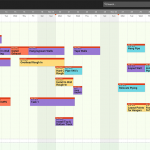Welcome to the first installment of Touchplan’s ConTech series. Over the next few weeks, we’ll be exploring how technology is changing the construction industry. In this first piece, we consider the industry trends that are driving the increase in development and funding of construction technology, and what barriers to adoption remain.
There’s a lot of buzz around construction technology lately. While technology has been gradually impacting the industry for some time now, more recent industry trends have added urgency to technology adoption. A widespread labor shortage, a booming market, rising material and labor costs, stagnant productivity, increasing project complexity and rising customer expectations are increasing the demand for tech solutions that can alleviate some of these pressures.
Investment in construction technology has skyrocketed to meet this increased demand. A recent report from professional services firm Jones Lang LaSalle, “The State of Construction Technology,” finds that venture capital investment in construction technology in 2018 is already at $1.05 billion, up almost thirty-percent from the year before. Investment in construction technology startups is currently surpassing that of startups in general, which emphasizes the churning activity in this sector. According to the report, collaboration software is the most active category, with sixty-three startups working in that space, closely followed by offsite construction and project management.
What Tech Are Companies Buying?
According to Software Connect’s recent “Construction Technology Trends — 2018 Report,” a survey of 158 small-to-midsize construction companies in North America, thirty-two percent of respondents plan to spend more on technology this year than they did in the previous year, and fifty percent plan to spend the same amount. Only eighteen percent plan to decrease their spending from last year. The types of technology many companies are considering include software, drones, new building materials, autonomous equipment, augmented/virtual reality and 3D printing, among others.
Construction management software (CMS), designed for contractors to facilitate the planning and management of construction projects, was a top priority among those who planned to increase their tech budgets. Forty-one percent of respondents planned to purchase or upgrade their CMS within the next twelve months. For this group, the highest-priority functions of a CMS product are project tracking, job costing and project estimating.
The highest priority for construction technology across the board was ease of use, which thirty-seven percent of respondents rated as their top consideration when purchasing technology, ahead of both functionality and cost.
Not Everyone Is Sold, but Those Who Buy, Win
Even as the use of construction technology becomes more prevalent, not all companies are ready to change. According to the Software Connect report, over seventy-five percent of companies that don’t use software always rely on manual, pen-and-paper-based processes, versus about twenty percent of the companies that have adopted technology.
However, the bulk of respondents who have adopted technology reported that they “seldom” or “never” rely on manual processes, which indicates that technology can change the way that construction companies work. And there is strong incentive to change—according to a survey by TrackVia, fifty-nine percent of respondents who rely on manual processes receive incomplete data on work quality, and sixty-five percent miss work and change orders.
Even when companies do invest in construction technology, they can face obstacles to company-wide adoption, which limits their return on investment. According to a 2017 report from McKinsey & Company, “The New Age of Engineering and Construction Technology,” the most common pitfalls are an insufficient commitment of resources to manage and update software and train employees in how to use it; a lack of training and buy-in from staff; and incompatibility of new technology with legacy systems that companies may have in place. Additionally, software that is difficult to use or access will severely hinder adoption.
How to Approach a ConTech Investment
It’s an inevitability that construction technology will change the industry. The constraints of a limited labor supply, costly materials, high demand, increasing project complexity and rising customer expectations will force contractors to look to new solutions to keep pace by working more efficiently.
When companies consider tech adoption, they should keep ease of use in mind. Technology offers no advantage if it isn’t used, so the greater the ease of adoption, the greater the likelihood of widespread use and a positive return on investment. Fortunately, well-designed, intuitive software is much easier to implement than the legacy systems of the past, and today’s workforce is more comfortable using technology than employees were just five or ten years ago.
In the same vein, a tool that can’t be easily accessed on the jobsite won’t be used as frequently, no matter how good its functionality may be. The Software Connect report found that construction industry respondents were five percent more likely to be open to cloud-hosted software than respondents from other industries, reflecting the unique demands of the construction industry. Ease of access is key to any successful construction technology investment, and increases the chances that strategic adoptions today will save companies money in the long run.
No matter what stage of the technology adoption process your company is at, these are important considerations. By keeping the needs of your users in mind and prioritizing ease of implementation, use and access, you can help guarantee your company’s future success.
In our next installment, we’ll go into more depth on the different types of construction technology on the market today, and what external factors can influence purchasing decisions.










